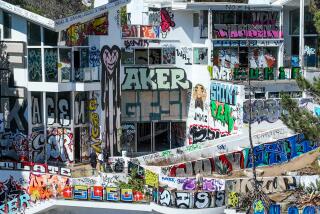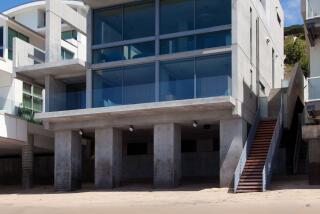Homeowner fights final battle to save his home
James Schneider says that when he dies, he hopes it will be in his sleep, inside his beloved Spanish-style home.
The ailing 77-year-old retiree and the modest one-story stucco house have been through a lot together. They’ve battled governments, bulldozers and petitioners. They’ve won beautification awards and been the subject of a book.
Sitting in the dining room recently, Schneider chuckled just thinking about his journey with the house. “I’m a lucky guy,” he said.
“After all the trouble I went through to save the house, I just want to climb into bed and never wake up,” he said.
But this tale of man and home is not over yet. The tall, lanky Nebraska native is once again trying to rescue his house -- this time, from foreclosure.
Schneider’s relationship with the three-bedroom house began in the summer of 1963 when he purchased it for $23,500 from the original owners, who had the house custom-built for them in 1933 by Silas Nowell, a renowned home designer and builder.
“It was such an elegant home,” Schneider said.
Its arched doorways, coved ceilings, clay tile roof, kitchen cabinets and hand-painted wall decorations contrasted sharply with Schneider’s childhood home, which lacked electricity and indoor plumbing.
But the house did have one major flaw; it sat across the street from Henry T. Gage Middle School in Huntington Park.
Barely a year after he bought the house, the Los Angeles Unified School District integrated the school, boosting the number of students and faculty. Parking quickly grew scarce. The district initiated plans to take nearby homes by eminent domain, so it could demolish them and build a parking lot. Schneider’s house was one of those targeted.
For two years, Schneider and the district fought over the home. But in the spring of 1966, a Los Angeles County jury ruled in the district’s favor, allowing it to purchase the home from Schneider. That fall he began searching for a new house, looking at more than 80.
“I looked and looked, but [the houses] were icky,” Schneider said.
In January 1967, the school district put Schneider’s home up for auction, with the condition that it be relocated. Schneider purchased his home for the minimum bid of $50. Finding a new site for the house was a little more difficult, however.
In Downey, six miles southeast, neighbors next to the Rio Hondo Country Club signed a petition to keep him from moving there. Residents contended that his home would devalue theirs.
In Bellflower, 12 miles southeast, he met no opposition but failed to get financing for the move. So with school district bulldozers poised to raze his home, Schneider moved his house to an open field in Bell Gardens. The home sat vacant for three months, its windows boarded, its missing chimney and fireplace sealed with plywood. Vandals punched holes in the walls.
Eventually Schneider found a vacant lot near Lanto Street and Gage Avenue, about a mile east from the field and four houses from a sign that read “Welcome to City of Commerce.”
So in August 1967, Schneider moved back into his home and began making repairs. He knew it would take a long time to restore the home’s grandeur, because he was intimately familiar with lengthy improvement projects.
Schneider was born in 1932, with a cleft palate and a crooked nose, in a farmhouse in Funk, Neb., a village with 100 residents. “I wasn’t pretty to look at,” he said.
When he moved to California at age 23, he underwent 13 operations over a three-year period to repair his face. The former Bethlehem Steel Corp. employee still keeps before and after photographs of his surgeries.
Schneider’s home makeover won the praise of the community and at least two powerful politicians. In 1970, he and the house received a beautification award from the city of Commerce, the first of three he would receive.
In 1971, “The House That Found a Home,” by Jim Kepner, was published. The book, a copy of which is at the Commerce Central Library, tells the story of Schneider’s struggle to save his home. It prompted both Sen. George McGovern and President Richard Nixon to praise Schneider for his efforts.
But what the book didn’t chronicle was Schneider’s latest struggle.
Almost $25,000 behind in mortgage payments, Schneider now stands to lose his home for good.
Gustavo Sanchez, a longtime friend who rents part of the storied house from Schneider and lives there with his wife and three kids, said he was unaware until recently that Schneider had stopped paying the mortgage. Now, Sanchez said, he is helping Schneider apply for a loan modification and hopes to extend the terms of the contract so Schneider can start making the payments.
“My wish is for Jim to keep the house and fulfill his wish to live and die here,” Sanchez said.
Meanwhile, Schneider, who said he has recently been diagnosed with early Alzheimer’s disease, is determined to save his home.
Sitting in his living room one recent afternoon, the proud homeowner looked around him. He eyed the home’s white coved ceiling, nickel wall sconces and stained-glass windows, then gazed upon the original oak wood flooring. It was installed the same year he was born.
“I won’t let them take this house,” he said. “I have chosen a nice place to die in.”
More to Read
Sign up for Essential California
The most important California stories and recommendations in your inbox every morning.
You may occasionally receive promotional content from the Los Angeles Times.







